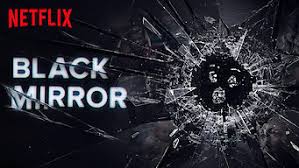by Meghan Buckley
When it comes to effective pedagogy some similar phrases are often thrown around—things like “contextualization,” “instructional conversation,” “tangible course outcomes,” and “reflective exercises,” among others. Very rarely does “watching Netflix” make its way into the discussion. It did this past semester in my EGL 130: “Literature, Science, Technology” class, though.
First airing on BBC and later co-opted by Netflix, the sci-fi series Black Mirror is an homage to the Twilight Zone with a contemporary spin; set in the uncomfortably near future, each episode asks its viewer to consider how technological innovations have the potential to wreak havoc on our methods of communication, our status as a human being, and our sense of morals. The “black mirror” of the show’s title is, of course, a reference to the black screens of our phones, televisions, laptops, and tablets and meta-reflexively asks us to consider how much our “digital selves”—those versions of us we project online and in other digital environments—actually align with the actions and morals of the people we are in the “real world.” Why are we more comfortable doing and saying things in digital formats that we would never do and say in real life? Is the cloak of anonymity that social media, emails, and text messages offer causing us to forget or, perhaps more sinisterly, ignore our responsibility to respect the rights and feelings of other human beings?
Throughout the semester, we watched episodes of Black Mirror to help contextualize and visualize the way that the humanities and sciences are inextricably linked, and how literary imaginings often predate and predict scientific innovation. In unit one, which was devoted to biotechnology and cloning, we read Kazuo Ishiguro’s novel Never Let Me Go, Joyce Carol Oates’ short story “BD 11 1 86,” Michael Cunningham’s mini-novella “Like Beauty” from his larger collection Specimen Days, and Caryl Churchill’s play “A Number.” While my students enjoyed comparing the way cloned and bioengineered bodies were commodified across these varied genres, what helped them visualize the “human” elements and impact of cloning most acutely was watching Black Mirror’s “Be Right Back.” In this episode from the series’ second season a young woman, Martha, mourns the sudden death of her husband, Ash, by way of beta-technology that mines Ash’s digital footprint (his social media posts, texts, emails, etc.) to construct a digital, disembodied “clone” that Martha can text and speak with on the phone. When “Ash’s” disembodied version suggests to Martha that she “upgrade” to the (rather expensive) physically cloned version of him
Martha agrees without hesitation, but as the episode draws to a close the audience sees her gradual awareness of the clone’s slight imperfections and lack of complete faithfulness to the personality and mannerisms of the original Ash. Between this episode and the readings, we debated what the “true purpose” of cloning was or could be. On the one hand, some students argued for cloning’s utility (i.e. the organ harvesting we see in Oates and Ishiguro, the potential to eradicate disease, etc.), while others defended cloning for what they perceived as its emotional benefits—the clone’s body to aid in the processes of mourning the loss of a loved one as Martha does, or to have a parenting “do over” as the main character, Salter, gets in “A Number.”
Besides opening our conversations to consider additional bioethical issues not found in our readings, I also noticed that the episodes we watched together in class helped elucidate some of the more complex theoretical readings I assigned. Our third unit of the course was devoted to surveillance through the lens of the military-industrial complex. As the semester was ramping up to its close, I felt comfortable challenging my students with excerpts from contemporary theory: we read Rob Nixon’s chapter on precision warfare from Slow Violence (2011), Derek Gregory’s essay “The Everywhere War,” and Gregory Chamayou’s intro to Theory of a Drone (2012). Admittedly, my students initially complained about these readings—I have never been accused of assigning what could be considered a “light” reading load in any of my courses and here was no exception; but the feedback I got about these texts was not they were “uninteresting,” just that they were “hard” and “took a long time to get through.” Anticipating this reaction, I had them watch Black Mirror’s “Men Against Fire” prior to reading the theory so that they had a visual example of both contemporary and futuristic wartime technologies juxtaposed against the ubiquitous truth of combat that both the episode and the readings underscore—no matter the time period, men and women at war fundamentally struggle to complete the act of killing another human being. The episode, named after S.L.A. Marshall’s famous 1947 study by the same name about soldiers’ aversion to “shoot to kill” in combat, proposes a technological solution to this pesky problem—an implant in soldiers’
brains that makes the enemy resemble a monster. With this technology the episode suggests that the “glitch” in our core human “software” is our empathy. Watching this episode allowed us to compare the futuristic technology of the episode’s MASS implant to the real-life technology of the chemical warfare described by Nixon and the detachment via distance of drone warfare analyzed by Gregory. In their blog posts and response papers for this unit I asked them: Do you think we will reach a point where advances in science and technology in certain arenas are “too” efficient? Are we reaching a saturation point where the technologies available to us obscure or eliminate the need for human thought and/or moral discernment?
Assigning and watching episodes of Black Mirror had a noticeable impact on our classroom dynamic in two specific ways. First, my students lit up when given the opportunity to watch and discuss a show most of them were already watching. Secondly, they were intrigued that the series reflected contemporary issues and concerns about the intrusive and corrupting influence of technology—something many of them claimed they were always/already thinking (and worried) about. As many English teachers know, creating a connection to the “real world” when reading fictional texts can be challenging, but when that connection is possible students tend to come alive in class and on the digital pages of their blogs and essays because they know that their opinions are based in and tied to contemporary issues and politics.
Inspired by this enthusiasm, their final project of the semester was Black Mirror-themed. I designed a group project where I asked them to title, cast, and create a plot for a fictional episode of Black Mirror. The only requirement was that their episode had to teach a lesson or highlight a fundamental issue of how the technology incorporated in their episode was responsible for the erasure of the core empathy and morality of the human. Below is the “official” assignment prompt:
At different points in the semester we watched episodes of the popular Netflix series Black Mirror. This series is set in the near-future and asks its viewers to consider the ways that technology interrupts or permanently alters the way human beings interact with one another. For this creative option, your group will conceptualize your own episode of Black Mirror. In your presentation you should 1) come up with a title for this episode, 2) cast the episode, 3) explain, in detail, the plot of the episode (you may incorporate some imagined dialogue if you wish), 4) explain why your group chose the particular technological problem/angle that you did (i.e. what inspired you?) and, most importantly, 5) identify what problems this technology/scientific advancement poses for the human and/or how does this advancement threaten the way human beings interact with one another/their capability for individual thought, agency, and artistic expression?
The results? Without exaggeration, I wanted to watch every single one of the episodes my students pitched to me. Some of the best ones included: A Never Let Me Go inspired episode about an illicit romance between two students in a society where babies are separated according to wealth and mental prowess at birth, the story of an undefeated but aging boxer who takes a pill in order to win a match against his younger opponent while knowing that this pill will accelerate his aging 20x the normal rate (very Rocky vibes, minus the FDA patent-pending drugs), and an episode cryptically titled “A Grand Design” in which a couple struggling with the costs of IVF enlist the help of a crowd-funding platform, but continue to accept funds even after the baby is born in exchange for allowing the “digital mob” to choose the child’s name, hobbies, college major, and future career (my favorite).
In our Q&A after each episode pitch, we took turns parsing out the literary and pop culture references interwoven into each “original” plot to underscore the pervasiveness of literature and the arts—even in conceptual pitches for works that didn’t yet exist like these fictive episodes. The students were particularly skilled at crafting titles, like the show itself, which were relatively meaningless at first glance but crystallized once the plot was further described and the standard “Black Mirror twist ending” was revealed. Most of the episodes would be “way too expensive” to make, my students reasoned in their presentations; but still, they had fun casting Meryl Streep to play an evil dictator (à la her role in The Manchurian Candidate) and Jennifer Lawrence and Eddie Redmayne starring opposite as “ill-fated lovers thwarted by the conventions of a futuristic society who refuses to understand.” More importantly, they showed a keen awareness of rhetorical situation as they carefully explained their casting choices, imagined dialogue, and necessary camera angles. Like in each episode of Black Mirror, by the end of the semester this project had us hard-pressed to discern what was real, what was possible, and what we only imagined.




Great article, thanks for sharing.
شركة تنسيق حدائق بالرياض